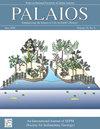生物结核的新定量描述指标(形状和大型钻孔):小安的列斯群岛和新西兰的实例
IF 1.5
4区 地球科学
Q2 GEOLOGY
引用次数: 0
摘要
提出了结壳(Ei)、大硼化(Mi)和不对称(Di)指数,作为生物结核的定量描述指标。(Ei)衡量结壳的数量,(Mi)衡量影响结核内部结构的钻孔痕迹的贡献,(Di)衡量核周围生物增生的规律性。后者用于构建可能的结壳形状分类方案。计算这些指数的原始数据来自对结核横截面数字化照片的数字处理。新西兰(平角海滩)和加勒比海(圣巴塞洛缪岛)潮下带温带和热带地区的碳酸盐结核分别计算了形态计量(Di)和堆积(Ei 和 Mi)指数。从这两种气候条件下的浅层高能环境中采集的有核红柱石的结果表明,它们的形态计量学和岩石学特征并不具有物种特异性(圣巴特岛的 Lithoporella/Mastophora 红柱石和新西兰的 Lithothamnion-Sporolithon 红柱石),而是取决于水动力条件和核的原始形状。在圣巴特附近较深水域(28 米)采样的 Acervulinid 巨型岩体不含岩核,其巨岩指数(Mi)明显高于较浅环境中的斜长石,这是由于波浪和水流的不连续影响以及沉积速率较低所致。 这里提出的定量描述指标可能:(1) 补充特定沉积环境中生物结核的特征;(2) 有助于含生物结核沉积的水动力和古环境重建;(3) 成为未来比较研究的宝贵工具。本文章由计算机程序翻译,如有差异,请以英文原文为准。
NEW QUANTITATIVE DESCRIPTORS (SHAPE AND MACROBORING) OF BIOGENIC NODULES: EXAMPLES FROM THE LESSER ANTILLES AND NEW ZEALAND
Encrusting (Ei), Macroboring (Mi), and Dissymmetry (Di) indices are proposed as quantitative descriptors of biogenic nodules. (Ei) measures the amount of encrustation, (Mi) the contribution of boring traces affecting the internal structure of nodules, and (Di) the regularity of the biogenic accretion around the nucleus. The latter has been used to construct a classification scheme of possible shapes for encrustations. Raw data to calculate the indices were obtained from numerical treatments of digitized photographs of nodule cross-sections. The morphometric (Di) and taphonomic (Ei and Mi) indices have been calculated for carbonate nodules from subtidal temperate and tropical settings in New Zealand (Flat Point Beach) and in the Caribbean (St. Bartholomew Island), respectively. Results for nucleated rhodoliths collected from shallow high-energy settings in these two climatic settings show that their morphometric and taphonomic characters are not species-specific (Lithoporella/Mastophora rhodoliths from St. Barth, and Lithothamnion-Sporolithon rhodoliths from New Zealand), but depend instead on hydrodynamic conditions and on the original shape of nuclei. Acervulinid macroids sampled in deeper waters (28 m) off St. Barth are nucleus-free and have a Macroboring index (Mi) significantly higher than that of rhodoliths from shallower environments, due to discontinuous influence of waves and currents, and low sedimentation rates. The quantitative descriptors proposed here might: (1) complement the characterization of biogenic nodules in specific depositional environments; (2) aid in hydrodynamic and paleoenvironmental reconstructions of biogenic nodule-bearing deposits; and (3) constitute valuable tools in future comparative studies.
求助全文
通过发布文献求助,成功后即可免费获取论文全文。
去求助
来源期刊

Palaios
地学-地质学
CiteScore
2.80
自引率
12.50%
发文量
40
审稿时长
6 months
期刊介绍:
PALAIOS is a monthly journal, founded in 1986, dedicated to emphasizing the impact of life on Earth''s history as recorded in the paleontological and sedimentological records. PALAIOS disseminates information to an international spectrum of geologists and biologists interested in a broad range of topics, including, but not limited to, biogeochemistry, ichnology, paleoclimatology, paleoecology, paleoceanography, sedimentology, stratigraphy, geomicrobiology, paleobiogeochemistry, and astrobiology.
PALAIOS publishes original papers that emphasize using paleontology to answer important geological and biological questions that further our understanding of Earth history. Accordingly, manuscripts whose subject matter and conclusions have broader geologic implications are much more likely to be selected for publication. Given that the purpose of PALAIOS is to generate enthusiasm for paleontology among a broad spectrum of readers, the editors request the following: titles that generate immediate interest; abstracts that emphasize important conclusions; illustrations of professional caliber used in place of words; and lively, yet scholarly, text.
 求助内容:
求助内容: 应助结果提醒方式:
应助结果提醒方式:


